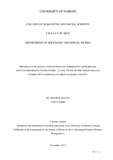| dc.description.abstract | Current Statistics indicate an increase in the magnitude, severity and complexity of disasters
from community to global level. Some of the factors blamed for this increased magnitude and
severity of disasters include: changing demographics, technological, environmental degradation,
climatic variability and change, and the impact of epidemics such as HIV/AID (UN/ISDR,
2005). This trend has been compounded by thepoor’s increasing vulnerability, resulting to
recurrent losses of their resources, livelihood asset base and capacities. Africa region, which
houses ten of the most vulnerable countries including Kenya, is one of the among the vulnerable
regions(UN 2002 & 2005). The ASAL communities in Kenya, especially the pastoralistsand
their livelihoods, are among the hardest hit by these disasters. With the Maasai owning nearly
half of the total livestock (Barrow and Mogaka, 2007) in ASAL areas, any threat to the Maasai
livelihoods not only impacts on the well-being of the community itself but the country’s
economy.
A close scrutiny of the past and current efforts in Disaster Management and Risk Reduction
(DMRR) efforts among the Kenyan pastoralist reveals a glaring omission of cultural factors as a
possible root cause of community vulnerability to disasters. The current DMRR efforts have
tended to focus on unsafe conditions and dynamic pressures, both of which are symptomatic,
leaving out cultural factors. Secondly, these DMRR approaches pass as “hard technology”
whose solutions are externally and institutionally driven with limited or no substantive “soft
technology” interventions such community participation and empowerment, which entails
community capacity to identify the root causes to disasters and dialogue on livelihoods. It this
glaring omission of root causes such as “social conventions” (or Maasaiceremonies), which is a
cultural issue and/or the “soft technology” approach in DMRR efforts that this study set out to
investigate.
The overall objective of this study was to determine the impact of social conventions on
community livelihoods andvulnerability to disasters.The four specific study objectives were to:
(a) establish the varioussocial conventions practiced by the Maasai of Osiligi community in
Namanga Division; (b) establish the types and number of livestock assets used by a Maasai
household in these conventions; (c) establish the existing community restocking mechanisms
and their sustainability; and (d) establish the extent to which the community has understood and
internalized the impact of social conventions to the household livestock base and vulnerability to
food insecurity and drought related disasters. To achieve these objectives, a study was
undertaken among the rural OsiligiMaasaifrom 10 villages in Namanga Division. A total of 219
people (i.e. 180 respondents, 14 key informants and 25 focused group members) were
5 | P a g e
interviewed. The response rate was 99.5 percent. Both probability (i.e. simple random,
systematic, and cluster sampling) and non-probability sampling techniques were used in
developing sampling frames and drawing sample sizes. Qualitative (i.e. KI and FGD interviews)
and quantitative (i.e administration of questionnaires) methods were employed in data collection
and information gathering. Quantitative data was processed using the SPSS statistical package
while qualitative information was processed using MS word. Analysis was done using
descriptive and inferential statistics.
The study found out that practice of social conventions accrued certain benefits to individuals,
household and the community in general including: promotion of individual’s identity and
dignity; enhanced unit among kinsmen; opportunity to pass on valuable cultural elements as well
as sustenance of Maasai culture. Despite these intrinsic and extrinsic cultural benefits, practice
of social conventions was found to make heavy demands on community reproductive resources,
especially livestock. The number of livestock used per ceremony ranged from one to 700 small
ruminants and one to 210 cattle. The cash equivalent of these livestock ranged between Kshs
4,000/= to Kshs. 16.0 million perceremony although this amount was said to be higher
considering the livestock sold to purchase other food stuff consumed during these conventions.
Other negative impacts included use of huge unproductive man-hours during preparation and
execution of these conventions; highilliteracy among youths,due to involvement in moranismor
early marriage; andenvironmentaldegradationduring construction of morancamps. Overall,
practice of social conventions impacted negatively on human, material, environmental and
economic community livelihood assets, capabilities, productive and reproductive activities. In
turn, these negative effects on community livelihoods contributed to increase in community’s
economic, social, environmental, attitudinal/motivational vulnerabilities to disasters.
Informed by these findings, this study recommended the following: social conventions should be
considered and addressed as one of the factors impacting negatively on community social,
financial, economic and environmental livelihood assets and vulnerability to disasters; the
community should explore alternative resources for use during execution of the conventions in
order to reduce the risk on livestock; there is need to diversify restocking practices to include
other effective and locally acceptable restocking approaches; and finally, create community
awareness and dialogue on the negative impact associated with practice of social conventions.
Future studies should investigate ways of tackling social conventions in disaster risk reduction
(DRR) programming; investigate how the Maasai governance structure can be used in regulating
the type and amount of resources, especially livestock used in social conventions; and
investigate the impact of social conventions on formal education. | en |

